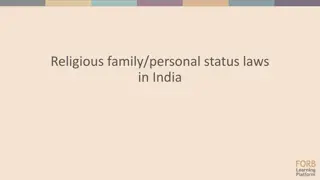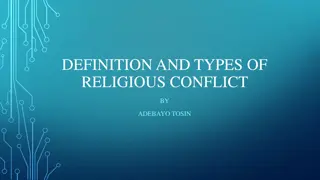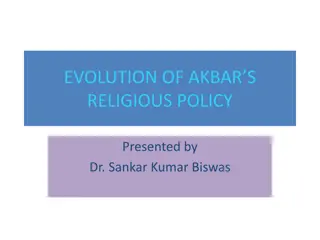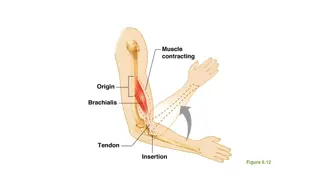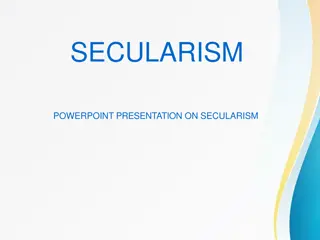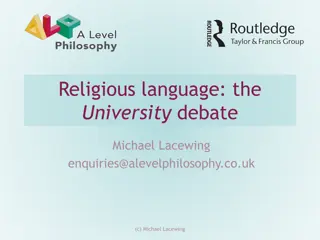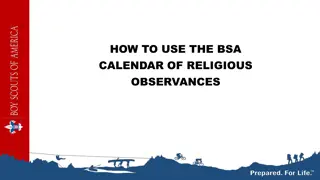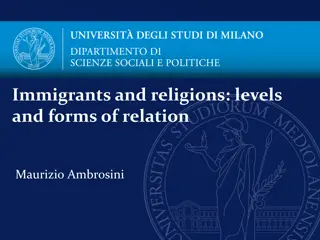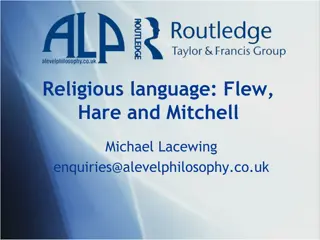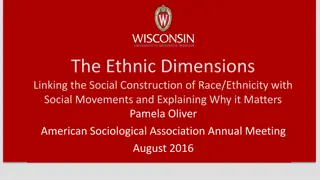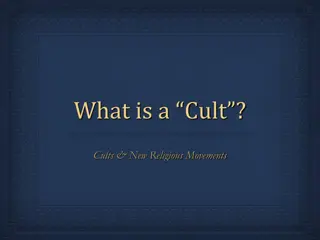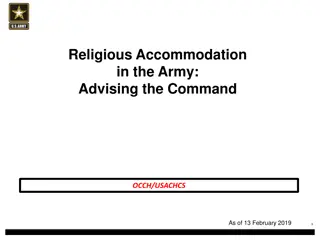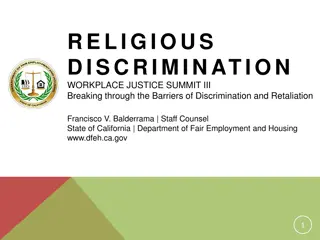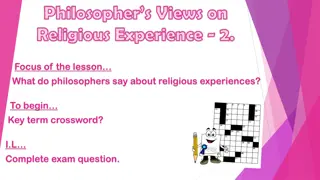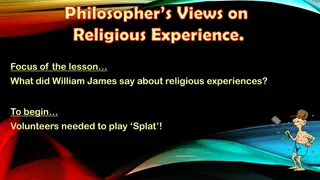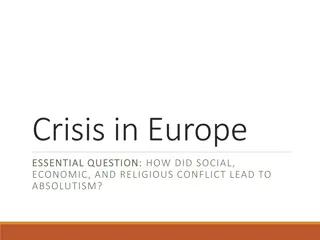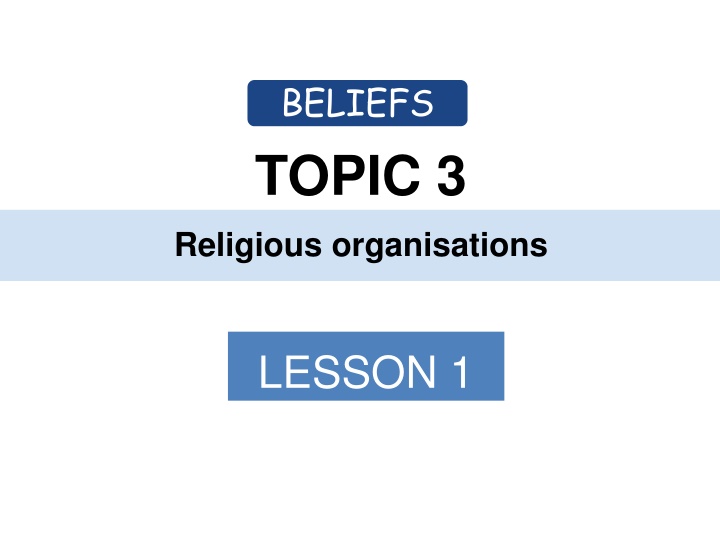
New Religious Movements: Features and Classification
Explore the key features and classifications of New Religious Movements (NRMs), including insights from Postmodernists, Eileen Barker, and Wallis. Learn about different types of NRMs and their characteristics in contemporary society.
Download Presentation

Please find below an Image/Link to download the presentation.
The content on the website is provided AS IS for your information and personal use only. It may not be sold, licensed, or shared on other websites without obtaining consent from the author. If you encounter any issues during the download, it is possible that the publisher has removed the file from their server.
You are allowed to download the files provided on this website for personal or commercial use, subject to the condition that they are used lawfully. All files are the property of their respective owners.
The content on the website is provided AS IS for your information and personal use only. It may not be sold, licensed, or shared on other websites without obtaining consent from the author.
E N D
Presentation Transcript
BELIEFS TOPIC 3 Religious organisations LESSON 1
Do Now Task - With a partner, recall the key features of what religion is like today according to Postmodernists. Use the image below to help . Postmodernists
Big Question: What happened in England after the Battle of Hastings? CSWK: What is a New Religious Movement? Key terms and definitions: SOME: I can evaluate the accuracy of categorising these New Religious Movements. MOST: I can explain using sociological evidence the features of and the reasons for New Religious Movements. ALL: I can describe what a New Religious Movement is by referring to examples of religious organisations. New Religious Movements used to cover the different types of religious movements growing.
ALL: I can describe what a New Religious Movement is by referring to examples of religious organisations. Task 1 A New Religious Movement are unconventional religious movements used to describe groups that were too complex to be categorised as a sect or cult. They increased dramatically during the 1960s and 1970s. Eileen Barker identifies 8 features which nearly all new religious movements have in common.... 1. They are r_ _ _ _ _ _ _ _. 2. Mostly have young _ _ _ _ _ _ as their members. 3. Membership is often t_ _ _ _ _ _ _ _. 4. Have a _ _ _ _ _ _ _ _ _ _ _ leader. 5. Only have one _ _ _ _ _ . 6. A sharp divide between us and _ _ _ _ . 7. Society views them as d_ _ _ _ _ _. 8. They are short _ _ _ _ d.
ALL: I can describe what a New Religious Movement is by referring to examples of religious organisations. Peer assess A New Religious Movement are unconventional religious movements used to describe groups that were too complex to be categorised as a sect or cult. They increased dramatically during the 1960s and 1970s. Eileen Barker identifies 8 features which nearly all new religious movements have in common.... 1. They are religious. 2. Mostly have young adults as their members. 3. Membership is often temporary. 4. Have a charismatic leader. 5. Only have one truth . 6. A sharp divide between us and them . 7. Society views them as deviant. 8. They are short lived. Copy down the eight features of a NRM according to Barker.
Task 2 WALLIScoined the term new religious movement to cover the different types of religious movements growing. He identifies between three different kinds of NRM. - WORLD REJECTING Similar to sects, extremely critical of mainstream society, members follow with total commitment and usually requires a change in lifestyle. For example - The People's Temple, The Moonies. - WORLD AFFIRMING Similar to client cults . Offer a service, and claim to allow people to achieve their full potential . They require little commitment (apart from the cost), and members can live a normal life. They do not oppose mainstream society. For example, EST, Transcendental meditation. - WORLD ACCOMMODATING These NRM s neither fully accept, nor fully reject mainstream values. They often stem from traditional religion, and attempt to revive traditions/beliefs which they have been lost in society. Neo-Pentecostalism for example, attempts to revive the worships of the Holy Spirit. Affirmation of the world The Middle ground Rejection of the world Accommodation of the world In your notes define the three kinds of new religious movement according to Wallis. S&C: What might the middle ground represent?
Task 3 STARK AND BAINBRIDGE Three different kinds of cults AUDIENCE CULTS Least organised and do not involve formal membership or much commitment. CLIENT CULTS Act as a relationship between a client and a consultant. Provide services to followers. CULTIC MOVEMENTS Most organised and demand higher level of commitment. NIEBUHR stated that sects are typically short lived for various reasons SECOND GENERATION - Those who are born into sects lack the commitment. PROTESTANT ETHIC Sects that practice ascetic tend to become prosperous. Such members will leave the beliefs. DEATH OF A LEADER Sects with charismatic leaders will collapse on the leader s death. ESTABLISHED SECTS (Wilson) Not all sects follow the patterns outlined. CONVERSIONST (Evangelicals) Aim is to convert large numbers of people. ADVENTIST (Jehovah s Witnesses) Await the second coming of Christ. They believe they must hold themselves separate from the corrupt world. Some sects have survived over many generations, such as Pentecostalism, The Amish and Mormons Using the information above, write a summary for the following key studies .. Stark and Bainbridge, Niebuhr and Wilson.
Task 4 Heaven's Gate A world-rejecting sect which believes that UFOs contain extra-terrestrial beings, and whose members believe that, by committing suicide together at the correct time, they will themselves be reborn as extra-terrestrials. In March 1997, when the Hale Bop comet, which members believed had a spaceship behind it to offer them rebirth, was at its nearest to earth, 39 men and women voluntarily committed suicide. The People's Temple A world-rejecting sect, founded by Jim Jones in the United States, but based finally in Guyana. Jones developed a belief called Translation, by which he and his followers would all die together in a mass suicide, and would move to another planet for a life of bliss. Following a shooting in 1978 carried out by the Temple's security guards, with 11 wounded and 5 killed, including a US Congressman on an inspection visit, Jones initiated a group suicide. In all, 638 adults and 276 children died, with most dying after drinking a grape drink laced with cyanide. Church of Scientology (www.scientology.org/home.html) A world-affirming cult, founded by science fiction writer L Ron Hubbard in the USA in the 1950s, this claims a membership of about eight million worldwide. It has been widely persecuted, but has now become more accepted. It believes that individuals can improve their lives through the application of the philosophy of Dianetics, and the removal of 'engrams' which cause mental health problems through 'auditing' by a member of the clergy using an 'e-meter'. The Unification Church (the 'Moonies1) (www.unification.org) A world-rejecting Christian-based sect, this was founded in 1954 in Korea by the Revd Sun Myung Moon (hence the nickname the 'Moonies'). Membership estimates range from one to three million in more than 150 countries. Many of their beliefs are similar to those of other Christian groups, though the Moonies also believe that the Revd Moon has been asked by God to complete the work that Jesus Christ started, and to unite all Christians into a single body. Transcendental Meditation (TM) (www.tm.org) A world-affirming cult founded by Maharishi Mahesh Yogi in India and brought to the West in the 1950s. This merges a simplified form of Hinduism with science, and believes that meditation can develop human potential and intelligence, and provide better health and career success; it is believed that individuals are eventually able to develop paranormal powers, such as levitating or flying in mid-air (yogic flying). Well over a million people have taken basic TM courses, and there are estimated to be tens of thousands of members worldwide. Identify those aspects of each group that fit the features of a new religious movement, and the reasons they may be classified as either sects or cults
Task 5 Watch the video clip below and note down any reasons why people were attached to and joined this group. Also, look out for any social characteristics that the followers had in common. https://www.youtube.com/watch?v=ydHRESPjBxg https://www.youtube.com/watch?v=VWq ACvTknls S&C Is this a fair representation for all new religious movements?
Task 6 As a class discuss reasons why someone might be attracted to joining a new religious movement. MARGINALITY WEBER Sects tend to arise in groups who are marginal to society. Such groups may feel they are dis-privileged not receiving their economic rewards or social status. Sects offer a solution to this through theodicy of dis-privilege religious explanation of their suffering. RELATIVE DEPRIVATION Subjective sense of being deprived. Possible for someone who is in a privileged position to feel like they are deprived or disadvantaged in some way. Although m/c people are materially well off, they may feel they are spiritually deprived, especially in today s materialistic, consumerist world. It is the relatively deprived who break away from churches to form sects. SOCIAL CHANGE Periods of rapid change disrupts and undermines established norms and values, producing anomie or normlessness. In response, those who are most affected by the disruption may turn to sects as a solution. Using your textbook, develop the three reasons above to explain the three reason why people join NRM s. S&C: what evaluations have been made of the way sociologists have tried to classify NRMs.
Plenary On the post-it-note provided to you, write down . Two things you have learn in todays lesson. One thing you would like to find out more about next lesson.

